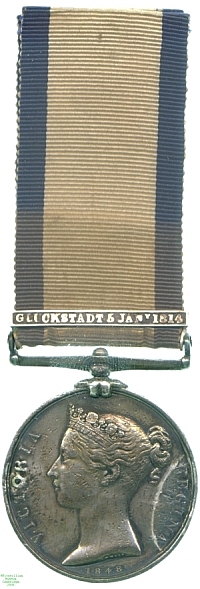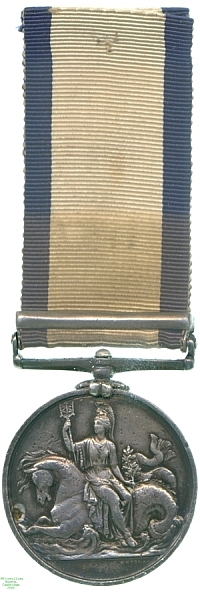
Obverse, a bust of Queen Victoria

Reverse, Britannia with a trident seated sideways on a seahorse

Obverse, a bust of Queen Victoria |

Reverse, Britannia with a trident seated sideways on a seahorse |
Just as in 1848 the extensive land campaigns of the Napoleonic Wars and the other conflicts of the pre-Victorian era were recognised by the issue of the Military General Service Medal, those serving in the Navy at the time were recognised with the Naval General Service Medal. As with the Army equivalent and the East India Company's related award, many of the battles for which the medal was awarded had been fought so long ago that few if any claimants survived.
In addition, bars were awarded for many actions whose significance and size were, despite the heroism displayed by those involved, relatively minor. The result was that many of the bars were issued in tiny numbers, with some combinations all but unique, and the medals command a very high price among collectors because of this rarity and individuality. This in turn, along with the manufacture in most cases of more bars than were eventually issued, has led to the `improvement' of many common awards where recipients' names are shared with those present at `rarer' battles. The medal also shares with the Military General Service and Army of India Medals the oddity that Queen Victoria, whose portrait they bear, was not the ruler under whom the battles for which it was awarded were fought.
By 1814 the land campaign against Napoleon I's France, now fighting alone except for some contingents troops from the Confederation of the Rhine, was clearly defeated. Despite numerous rallying battles by Napoleon the Allied advance on Paris was unstoppable. Meanwhile the British Navy commenced the breaking down of the further walls of Napoleon's `Fortress Europe' that they had for so long blockaded. As part of this effort, on 5 January 1814 a squadron of 5 ships and 8 gunboats under Captain A. Farquhar in the frigate HMS Desirée forced entry into the town of Gluckstadt, in Schleswig-Holstein, and demolished its fortifications. 45 NGSMs were awarded with bars for this action in 1848.
This example was awarded to Midshipman John P. Brouncker of the Desirée. His medal has suffered somewhat, and was at some point in its history mounted as a brooch, but his service in the campaign is verified and the Medals Roll confirms the award of the piece to him. Lester Watson bought it from the dealer Gifford at some point before 1928; it had previously been sold at Sotheby's in November 1910.